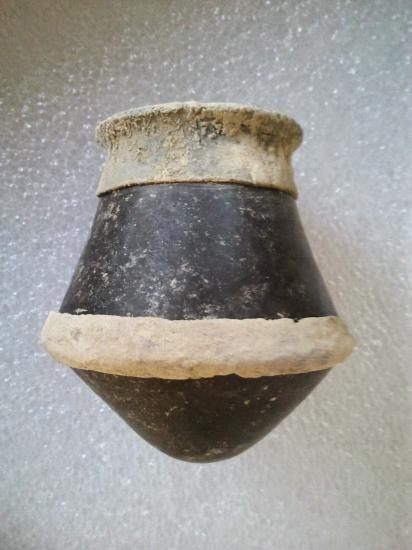PART.2
The abundance of silver is especially notable, since archaeologists also found nine other objects made of silver, including rings, earrings and bracelets. They also discovered that the nails used to hold the handle of an elaborate bronze dagger were made of silver.
One of the most admirable items is nonetheless a small ceramic cup with the rim and outer part covered in fine layers of silver and which constitutes a pioneering example of silverwork on vessels.
Small cup decorated with silver [Credit: Universitat Autònoma de Barcelona]
The last item worth mentioning is a metallic punch with a bronze tip and a handle forged in silver. This item is considered unique and archaeologists were surprised to discover the perfection with which it was crafted and the grooved designs which decorate the top of the punch.
According to researchers, the artefacts found at La Almoloya are of great historical and patrimonial relevance. Their interest transcends local scale and should be considered of first order for all of Europe. They assure that the items are unique and that in addition to their intrinsic value, there is also the fact that they are perfectly contextualised. The archaeologists also stress the need to conserve, study and disseminate these findings.
La Almoloya contains many unknown answers and offers many promising perspectives for future digs. The completion of the urban tissue and revealing the details of the first political structure of the West are some of the challenges remaining, archaeologists conclude.
A Team Expert in the Argaric Culture
The team in charge of the archaeological dig at La Almoloya is led by Vicente Lull, Rafael Micó, Cristina Rihuete and Roberto Risch, professors of the Universitat Autònoma de Barcelona. The same team had previously made important discoveries at the La Bastida site, another dig site in Murcia from the Bronze Age. From 2008 to 2012 the team was able to unearth a large fortification and several constructions found in the Argaric city.
The digs carried out at La Almoloya received funding from the firm CEFU, SA, owner of the land on which the site is located, and from Universitat Autònoma de Barcelona. The Council of Education, Culture and Universities of the Region of Murcia has also offered support to the research.
Presentation at the Archaeological Museum in Madrid
The discoveries will be the focus of an event offered today 8 October at 6 pm at the Archaeological Museum in Madrid. UAB researchers will present the results of the dig and speak on the importance of the La Almoloya and La Bastida sites for the study of the Bronze Age and the Argaric culture.
Also speaking will be researchers Kristian Kristiansen, from the University of Gothenburg, and Robert Chapman, from University of Reading, who will compare the sites in Murcia to the societies of continental Europe and what is known about the political relations existing in the Bronze Age.
The event will include the presence of Pedro Antonio Sánchez, councillor of Education, Culture and Universities of the Region of Murcia; Enrique Varela, Vice Director General of National Museums for the Ministry for Education, Culture and Sports; Andrés Carretero, Director of the National Archaeological Museum of Spain; and Manel Sabés, Vice Rector for Institutional Relations and Environment.
Archaeologists from the UAB shed light on the rich historical and archaeological heritage of the site of La Almoloya, located in Murcia. A silver diadem discovered in the royal tomb is the only one from that era conserved in Spain.
Video (TVE/UAB) = http://www.uab.cat/web/newsroom/news-detail/bronze-age-palace-and-grave-goods-discovered-1345668003610.html?noticiaid=1345676313107